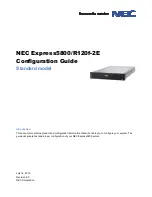
2.6
Space Reclamation
The space reclamation process performs multiple functions on the ETERNUS CS800.
When data is deduplicated it is stored in a block pool - a pool of all unique data blocks that
were captured during the data deduplication cycle. When subsequent backup jobs occur, the
data deduplication engine searches for new data entering the ETERNUS CS800 and uses a
variable length compression algorithm to compare new data to existing data in the block pool.
Unique blocks are added to the block pool and known blocks are indexed.
The space reclamation function searches the blockpool for data blocks that are not
referenced by any pointers (that is, the files associated with the block have been expired and
removed). Once such a data block is identified, the block is removed to make the space
reusable.
For correct system operation, space reclamation
must
be run at regular intervals (at least
once a week). Fujitsu Technology Solutions recommends creating a schedule to
automatically run space reclamation (see
"Scheduling Space Reclamation" on page 293
).
It may be beneficial to schedule space reclamation for a time when other operations are not
normally being carried out. Therefore it is important to know when to schedule the space
reclamation process. As best practice it is recommended that this process commences at
least two hours after your backup job has completed on a daily basis. It is far more efficient to
process a day’s worth of new data than a week’s worth.
2.7
Remote Replication
Today most backup occurs on isolated devices, making it difficult to deploy disk backup
when disaster recovery protection is required. ETERNUS CS800 solutions use data
deduplication and replication to decrease by up to 50 times the bandwidth required to move
backup data over networks and between sites. This dramatic gain makes it practical and
cost-effective for users to replicate backup data over WANs for secure, network-based
disaster recovery protection, and it lets users combine rapid, local restores with sound
disaster recovery protection.
With ETERNUS CS800 replication, users can transmit data from a single site or multiple
sites to a central location using any ETERNUS CS800.The replication is an asynchronous,
automated background process that includes encryption of data in transit. This model for
protecting the distributed enterprise allows users to combine disk, replication, and tape for an
optimal combination of performance, simplicity, and security.
For more information on implementing a replication plan, see
ETERNUS CS800
35
2 System Description
Содержание ETERNUS CS800
Страница 1: ...ETERNUS CS800 V3 2 User Guide English ...
Страница 2: ......
Страница 3: ...English ETERNUS CS800 User Guide V3 2 Edition October 2015 ...
Страница 26: ...26 ...
Страница 42: ...42 ...
Страница 78: ...78 ...
Страница 114: ...6 3 Running the Getting Started Wizard 6 3 3 Network Configuration Figure 80 Network Configuration 114 ETERNUS CS800 ...
Страница 132: ...6 3 Running the Getting Started Wizard Figure 91 Confirm Page 132 ETERNUS CS800 ...
Страница 143: ...Figure 97 Remote Management Pages Map ETERNUS CS800 143 7 Remote Management ...
Страница 144: ...144 ...
Страница 184: ...8 7 AIS Connect Figure 128 AISConnect Wizard Confirm 184 ETERNUS CS800 ...
Страница 198: ...198 ...
Страница 321: ...Figure 206 Network Configuration ETERNUS CS800 321 10 Configuration ...
Страница 335: ...Figure 215 Date Time Page To set the system date and time ETERNUS CS800 335 10 Configuration ...
Страница 339: ...Figure 216 Access Control Settings Page ETERNUS CS800 339 10 Configuration ...
Страница 362: ...362 ...
Страница 432: ...432 ...
Страница 476: ...476 ...
Страница 494: ...494 ...
Страница 600: ...600 ...
















































